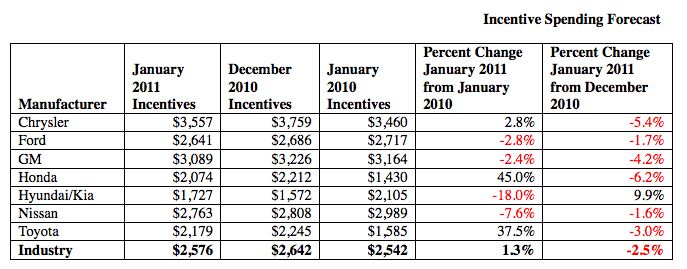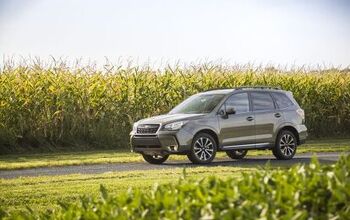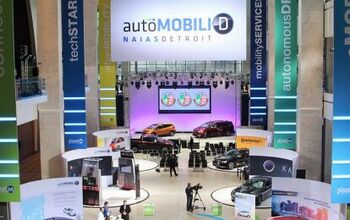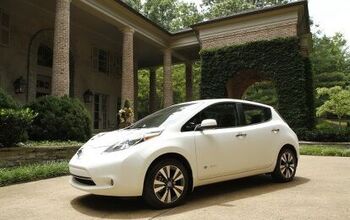January Incentive Report
As any sales-watcher knows, volume isn’t everything. Fleet-retail mixes, incentive spending and transaction prices are all important considerations for putting volume numbers into context. As usual, we’ve assembled Edmunds’ True Cost Of Incentives index as well as TrueCar’s Transaction Pricing and Incentive Spending forecasts, for a complete picture of these important metrics… and after the jump, we’ve added a few notes on the discrepancies between the two firms’ numbers.
There are a few inevitable discrepancies between the Edmunds and TrueCar incentive spends, which we have learned are due to TrueCar’s inclusion of volume-based spiffs and differences in lease-subsidy calculation. Which number is closest to the truth? Well, much of TrueCar’s team used to do forecasting at Edmunds, and though non-disclosure agreements prevent them from explaining in detail how their secret sauce is better, it makes sense that they’d be trying to offer more than their previous employer (and they claim their data is based on more transactions than any other forecasting firm). Meanwhile, Edmunds’ forecasters say they’re “not comfortable” including tough-to-calculate volume-based spiffs. In short, either number could be off a little… but if I had to put money on it, I’d lean towards TrueCar’s numbers.
So, did GM rule incentive spending last month, or did Chrysler? Edmunds calculates that GM spent $3,762 per vehicle, but TrueCar sees The General at a much lower $3,089 average. Edmunds put Chrysler at second place with $3,386 per vehicle, while TrueCar puts ChryCo first with $3,557. Whether this discrepancies are accounted for by lease calculations or volume-based dealer spiffs isn’t at all clear, but TrueCar’s first-place ranking for Chrysler does seem to indicate that one of these factors is pushing up Chrysler’s incentive average. Similarly, the nearly-$500 difference between Honda’s two January 2011 incentive spend forecasts indicates that Honda may be dipping into the volume-based incentives that TrueCar tracks. Either way, it’s clear that incentives are headed down across the board in the short-term (although Honda and Toyota are still up huge in terms of year-over-year gains).
In the short-term, transaction prices seem to be rising slowly from their December levels, although the industry-wide average is still half a percent off its January 2010 mark. In the short-term, only GM appears to be losing ground on transaction pricing (which, taken with incentive levels, give some cause for worry), although over the last year, Honda and Toyota are clearly the biggest losers when it comes to transaction price. Part of that may be tied to falling consumer perceptions, but there’s another, somewhat perverse dynamic at play. TrueCar’s Jesse Toprak explains
Transaction prices dropped slightly in January as consumers purchased a relatively higher percentage of small cars and compact SUVs. If gas prices continue to rise, transaction prices could continue to decline, as consumers tend to shift purchases to smaller, more fuel-efficient vehicles
And because the Detroit automakers gain the greatest transaction-price benefits from strong truck and SUV sales, their transaction price levels could well be the first to suffer from a prolonged rise in fuel prices.
More by Edward Niedermeyer
Latest Car Reviews
Read moreLatest Product Reviews
Read moreRecent Comments
- Alan My view is there are good vehicles from most manufacturers that are worth looking at second hand.I can tell you I don't recommend anything from the Chrysler/Jeep/Fiat/etc gene pool. Toyotas are overly expensive second hand for what they offer, but they seem to be reliable enough.I have a friend who swears by secondhand Subarus and so far he seems to not have had too many issue.As Lou stated many utes, pickups and real SUVs (4x4) seem quite good.
- 28-Cars-Later So is there some kind of undiagnosed disease where every rando thinks their POS is actually valuable?83K miles Ok.new valve cover gasket.Eh, it happens with age. spark plugsOkay, we probably had to be kewl and put in aftermarket iridium plugs, because EVO.new catalytic converterUh, yeah that's bad at 80Kish. Auto tranny failing. From the ad: the SST fails in one of the following ways:Clutch slip has turned into; multiple codes being thrown, shifting a gear or 2 in manual mode (2-3 or 2-4), and limp mode.Codes include: P2733 P2809 P183D P1871Ok that's really bad. So between this and the cat it suggests to me someone jacked up the car real good hooning it, because EVO, and since its not a Toyota it doesn't respond well to hard abuse over time.$20,000, what? Pesos? Zimbabwe Dollars?Try $2,000 USD pal. You're fracked dude, park it in da hood and leave the keys in it.BONUS: Comment in the ad: GLWS but I highly doubt you get any action on this car what so ever at that price with the SST on its way out. That trans can be $10k + to repair.
- 28-Cars-Later Actually Honda seems to have a brilliant mid to long term strategy which I can sum up in one word: tariffs.-BEV sales wane in the US, however they will sell in Europe (and sales will probably increase in Canada depending on how their government proceeds). -The EU Politburo and Canada concluded a trade treaty in 2017, and as of 2024 99% of all tariffs have been eliminated.-Trump in 2018 threatened a 25% tariff on European imported cars in the US and such rhetoric would likely come again should there be an actual election. -By building in Canada, product can still be sold in the US tariff free though USMCA/NAFTA II but it should allow Honda tariff free access to European markets.-However if the product were built in Marysville it could end up subject to tit-for-tat tariff depending on which junta is running the US in 2025. -Profitability on BEV has already been a variable to put it mildly, but to take on a 25% tariff to all of your product effectively shuts you out of that market.
- Lou_BC Actuality a very reasonable question.
- Lou_BC Peak rocket esthetic in those taillights (last photo)





































Comments
Join the conversation
If you look at TrueCar's numbers to calculate discount %, you get: -12.3% Chrysler -10.1% Nissan -9.2% Kia -9.1% GM -8.6% Toyota -8.4% Hyundai -8.3% Honda -8.3% Ford GM's not doing badly at all. As the bailout fades in people's memory, and new product comes out, their discount ratio should drop even farther. Chrysler, well, a mediocre car from a mediocre company needs more on the hood to move.
Needless to say, you know who WE at TRUECar.com think has the more accurate numbers. Nice piece, Ed. Let us know if there is anything we can do for you. 86er, trucks continue to lead all categories in sales, so it males sense that the Big 3 continue to focus there. Notice, though, that despite all of the sales, it is green cars and smaller vehicles that garner the innovation....